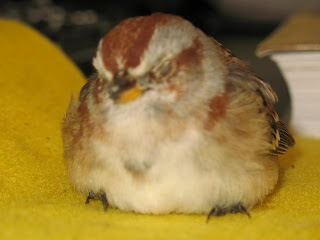
At 9 AM today, while I was opening up the Beczak Environmental Education Center, I found a small brown bird lying in a ball on the ground. Its feathers were puffed up, which is what birds do to conserve their body heat. I picked it up and checked its wings and feet to see if the bird was hurt. Everything seemed fine except one of its eyes wouldn’t open. I tried to warm the bird by rubbing it gently between my gloves. When that didn’t seem to work, I fetched a piece of felt to wrap the bird in, and brought it inside.
I put the bundle in a shoebox on my desk and took a close look. Its bill was yellow and black, and it had a rusty-colored eye line and crown. There was a small dark spot on its chest. These arks identified it as an American Tree Sparrow, or Spizella arborea, which I double-checked in National Audubon Society: The Sibley Guide to Birds. This common Hudson Valley bird winters in small flocks in brushy habitats alike the Beczak marsh.
In a few hours, the bird began to move around. I could tell it had defrosted, and I released it back to its winter home.
Dorene Sukup
Educator
Dorene Sukup
Educator





